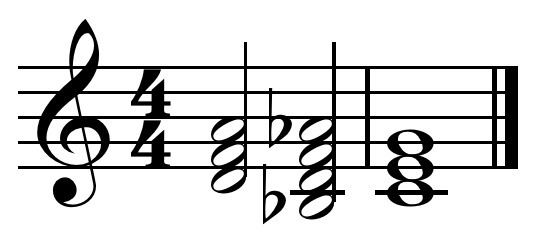 | ||
In jazz and jazz harmony, the chord progression from ii7 or IV7 to ♭VII7 to I has been nicknamed the backdoor progression or the backdoor ii-V, as described by jazz theorist and author Jerry Coker. This name derives from an assumption that the normal progression to the tonic, the ii-V-I turnaround (ii-V7 to I, see also authentic cadence) is, by inference, the front door. It can be considered a minor plagal cadence in traditional theory (see modal interchange and plagal cadence).
The backdoor progression can be found in popular jazz standards in such places as measures 7 and 8 of the A section of "Cherokee," measures 9 and 11 of "My Romance" or measures 10 and 28 of "There Will Never Be Another You," as well as Beatles songs like "In My Life" and "If I Fell."
The ♭VII7 chord, a pivot chord borrowed from the parallel minor of the current key, is a dominant seventh. Therefore it can resolve to I; it is commonly preceded by IV going to iv, then ♭VII7, then I. In C major the dominant would be G7: GBDF, sharing two common tones with B♭7: B♭DFA♭. A♭ and F serve as upper leading-tones back to G and E, respectively, rather than B♮ and F serving as the lower and upper leading-tones to C and E.
The term "Backdoor" has been used by author Shelton Berg to refer another entirely unrelated progression. The unexpected modulation created through the substitution of the highly similar Imaj9 for iii7 (in C: CEGBD and EGBD) at the end of the iiø7-V7 turnaround to iii (iiø7/iii=♯ivø7, V7/iii=VII7, iii), arrives at 'home' (the tonic) through unexpected means, the 'back' instead of the 'front door'(iii7, EGBD, being entirely contained within Imaj9, CEGBD, and the seventh still resolving downward). The resolution of a dominant seventh chord up a step (in this case a half-step) is called a deceptive cadence.
